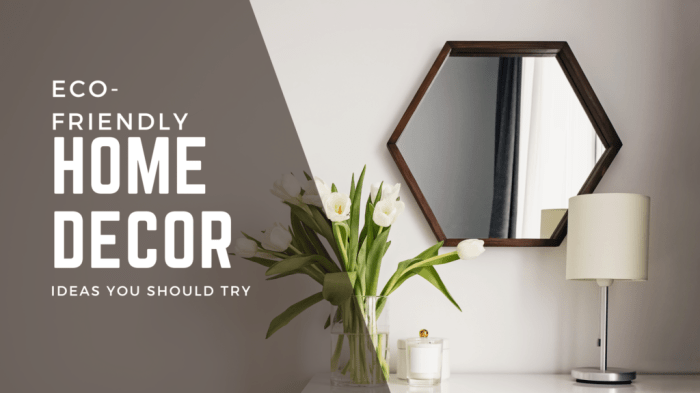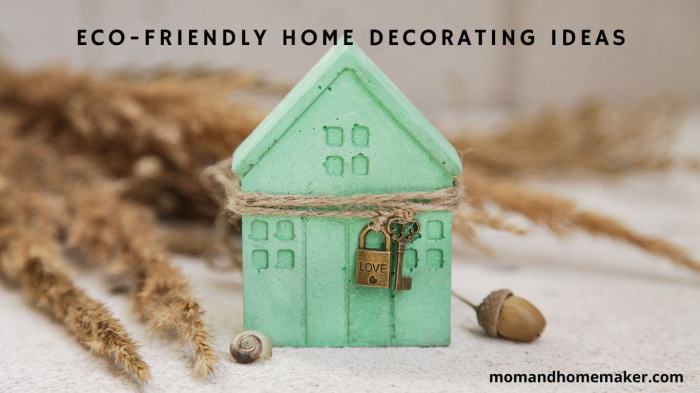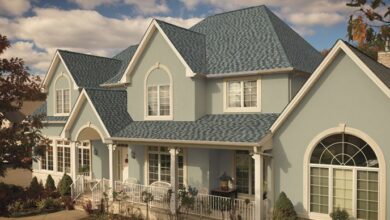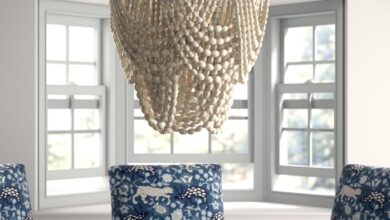Sustainable Home Decor A Guide to Eco-Friendly Design
Sustainable home decor represents a conscious shift towards environmentally and socially responsible interior design. It’s more than just a trend; it’s a commitment to minimizing the environmental footprint of our living spaces while supporting ethical production practices. This guide explores the key principles, materials, styles, and practices that define sustainable home decor, empowering you to create a beautiful and responsible home.
From understanding the lifecycle impact of materials to sourcing ethically and reducing waste, we delve into practical strategies for incorporating sustainable practices into your home. We’ll examine various sustainable materials, such as reclaimed wood and bamboo, compare their properties, and discuss how to integrate them seamlessly into your design aesthetic. We’ll also highlight emerging trends in sustainable decor and offer budget-friendly options, ensuring that eco-conscious design is accessible to everyone.
Defining Sustainable Home Decor
Sustainable home decor goes beyond simply choosing aesthetically pleasing items for your living space. It’s a holistic approach that considers the environmental and social impact of every stage of a product’s life, from material sourcing to disposal. This encompasses the materials used, the manufacturing processes employed, and the overall lifecycle impact on the planet and its people. The goal is to create beautiful and functional homes while minimizing harm and maximizing positive contributions.Sustainable home decor prioritizes the use of eco-friendly materials, ethical production practices, and durable, long-lasting designs.
It promotes responsible consumption and reduces waste, fostering a connection between our living spaces and the well-being of the environment. This approach aligns with broader principles of sustainability, encouraging mindful choices that benefit both present and future generations.
Materials Used in Sustainable Home Decor
Sustainable home decor emphasizes the use of materials with minimal environmental impact. This includes reclaimed wood, sustainably harvested bamboo, organic cotton, recycled metals, and upcycled materials. The selection process considers the origin of materials, ensuring they are sourced responsibly and ethically, minimizing deforestation and pollution. For example, reclaimed wood salvaged from old buildings reduces the demand for newly harvested timber, lowering carbon emissions and preserving forests.
Similarly, using organic cotton avoids the harmful pesticides and chemicals associated with conventional cotton farming, protecting both the environment and the health of farmworkers.
Production Processes in Sustainable Home Decor
The manufacturing processes involved in creating sustainable home decor items are equally important. Sustainable practices focus on minimizing energy consumption, reducing water usage, and limiting waste generation during production. Fair labor practices, ensuring safe and ethical working conditions for all involved in the manufacturing process, are also central to the definition. Companies committed to sustainability often utilize renewable energy sources in their factories and implement closed-loop systems to recycle and reuse materials, reducing overall environmental impact.
For instance, a company might use solar power to operate its facilities and implement a system to collect and reuse water used in the manufacturing process.
Lifecycle Impact of Sustainable Home Decor
The lifecycle impact of a product encompasses its entire journey, from raw material extraction to eventual disposal. Sustainable home decor aims to minimize the environmental footprint throughout this entire process. This involves designing products for durability and longevity, reducing the need for frequent replacements. It also includes considering the end-of-life management of the product, encouraging repairability, recyclability, or biodegradability to prevent waste ending up in landfills.
For example, a sustainably designed piece of furniture might be made from easily replaceable parts, extending its lifespan and reducing the need for replacements. Similarly, a rug made from natural fibers would be biodegradable, minimizing its environmental impact at the end of its life.
Environmental and Social Benefits of Sustainable Home Decor
Adopting sustainable practices in home decoration offers significant environmental and social benefits. Environmentally, it helps to reduce carbon emissions, conserve natural resources, and minimize pollution. Socially, it supports ethical labor practices, promotes fair trade, and contributes to the economic well-being of communities involved in the production process. By choosing sustainable home decor, consumers directly support businesses and initiatives committed to environmental and social responsibility, creating a positive ripple effect throughout the supply chain.
This fosters a more equitable and environmentally conscious global economy.
Sustainable Materials in Home Decor
Choosing sustainable materials for home decor is crucial for minimizing environmental impact and promoting healthier living spaces. By opting for responsibly sourced and ethically produced materials, we can reduce our carbon footprint and support sustainable practices throughout the supply chain. This section will explore various sustainable materials commonly used in home décor, comparing their properties and environmental implications.
Common Sustainable Materials and Their Properties, Sustainable home decor
Sustainable materials offer a diverse range of options for home decor, each with unique characteristics. Understanding these properties allows for informed decision-making, ensuring the chosen materials align with both aesthetic preferences and environmental values.
| Material | Source | Advantages | Disadvantages |
|---|---|---|---|
| Reclaimed Wood | Demolished buildings, old barns, etc. | Unique character, durability, reduced deforestation, lower carbon footprint | Can be expensive, may require significant restoration, availability varies |
| Bamboo | Rapidly renewable grass | Strong, lightweight, sustainable, aesthetically pleasing, relatively inexpensive | Susceptible to moisture damage if not properly treated, can be brittle |
| Organic Cotton | Organically farmed cotton plants | Soft, breathable, hypoallergenic, reduced pesticide use, biodegradable | Can be more expensive than conventionally grown cotton, requires more water in some farming practices |
| Cork | Bark of the cork oak tree | Renewable, sustainable harvesting, lightweight, insulating, fire-resistant | Can be less durable than some other materials, limited color options |
| Seagrass | Seagrass plants harvested sustainably | Durable, naturally water-resistant, breathable, adds a natural aesthetic | Can be susceptible to mold or mildew if not properly cared for, availability can vary depending on region |
| Hemp | Hemp plant | Durable, strong, biodegradable, requires less water than cotton, versatile | Can be more expensive than some other fabrics, may require special care |
Environmental Impact Comparison of Sustainable Materials
The environmental impact of each sustainable material varies depending on factors such as sourcing, processing, and transportation. Reclaimed wood, for example, boasts a significantly lower carbon footprint compared to newly harvested wood due to the elimination of the manufacturing process. Bamboo, known for its rapid growth rate, offers a highly renewable resource, but its transportation can still contribute to emissions depending on the distance traveled.
Organic cotton, while reducing pesticide use, may still have a higher water footprint compared to some other fibers, depending on farming practices. Therefore, a holistic approach considering the entire lifecycle of a material is necessary for a truly sustainable choice.
Sustainable Decor Styles and Trends
Sustainable home decor is evolving beyond simply using eco-friendly materials; it’s embracing a holistic approach that considers the entire lifecycle of products and their impact on the environment and society. This includes mindful consumption, supporting ethical production, and choosing designs that prioritize durability and longevity. Emerging trends reflect a growing awareness of these factors, leading to innovative and aesthetically pleasing solutions.
The movement towards sustainable living is significantly influencing design aesthetics, pushing for a shift away from fast fashion and disposable items towards timeless pieces with enduring appeal. This translates into a preference for natural materials, handcrafted items, and designs that prioritize functionality and minimal waste. The philosophy underpinning these trends emphasizes reducing environmental impact while enhancing the quality of life within the home.
Minimalist Sustainable Decor
Minimalist sustainable decor focuses on functionality and reducing clutter. The style prioritizes quality over quantity, selecting durable, ethically sourced pieces that will last for years. A typical minimalist sustainable space might feature a neutral color palette, natural materials like wood and linen, and a limited number of carefully chosen accessories. Imagine a living room with a simple, handcrafted wooden coffee table, a comfortable linen sofa in a natural beige tone, and a few strategically placed plants.
The overall effect is clean, calming, and environmentally conscious. The absence of excessive decoration emphasizes the beauty of the natural materials and the functionality of the furniture.
Japandi Sustainable Decor
Japandi style blends the minimalist aesthetics of Japanese design with the functionality and warmth of Scandinavian design. This results in a serene and sophisticated style that emphasizes natural materials, clean lines, and a muted color palette. Sustainable elements are incorporated through the use of reclaimed wood, bamboo, and organic cotton textiles. A picture of a Japandi bedroom might show a low platform bed made of light-colored wood, complemented by natural fiber rugs and simple, elegant lighting.
The overall feel is calm, balanced, and environmentally responsible, highlighting the beauty of simplicity and natural materials.
Bohemian Sustainable Decor
Bohemian sustainable decor retains the eclectic and layered nature of traditional bohemian style but incorporates sustainable practices and materials. This means using recycled or upcycled furniture, vintage textiles, and natural fibers like jute and organic cotton. The emphasis is on creating a unique and personalized space that reflects the owner’s individuality while minimizing environmental impact. Visualize a living room with a mix of vintage rugs layered on the floor, macrame wall hangings made from recycled materials, and furniture crafted from reclaimed wood.
The overall aesthetic is relaxed, creative, and environmentally friendly, showcasing the beauty of repurposed and natural elements.
List of Popular Sustainable Home Decor Styles
The following list summarizes several popular sustainable home decor styles, highlighting their key characteristics.
- Minimalist: Emphasizes functionality, quality over quantity, and natural materials.
- Japandi: Blends Japanese minimalism with Scandinavian functionality, using natural materials and a muted palette.
- Bohemian: Incorporates recycled and upcycled items, vintage textiles, and natural fibers.
- Rustic: Utilizes reclaimed wood, natural stone, and other raw materials, emphasizing handcrafted elements.
- Modern Farmhouse: Combines modern design elements with rustic materials, focusing on practicality and sustainability.
Sustainable Sourcing and Production
Sustainable sourcing and production are fundamental to creating truly sustainable home decor. It’s not enough to simply use sustainable materials; the entire process, from the origin of raw materials to the final product, must minimize environmental impact and uphold ethical labor practices. This ensures that the positive environmental aspects of sustainable decor aren’t offset by negative social or economic consequences elsewhere in the supply chain.Ethical sourcing in sustainable home decor prioritizes fair wages, safe working conditions, and environmental protection throughout the supply chain.
This means ensuring that the people involved in producing the goods – from farmers and artisans to factory workers – are treated fairly and with respect, and that the environment is not harmed in the process. Ignoring these ethical considerations undermines the very principles of sustainability, rendering the “sustainable” label meaningless.
Certifications and Labels Indicating Sustainable Practices
Several certifications and labels help consumers identify products made with sustainable practices. These certifications provide independent verification of ethical sourcing and environmental responsibility, allowing for informed purchasing decisions. Recognizing these labels empowers consumers to support businesses committed to sustainability.
- Forest Stewardship Council (FSC): This certification ensures that wood and paper products come from responsibly managed forests, promoting biodiversity and preventing deforestation.
- Fair Trade Certification: This label guarantees that products are made under fair labor conditions, ensuring fair wages and safe working environments for producers, often in developing countries.
- Global Organic Textile Standard (GOTS): This certification verifies that textiles are made from organically grown fibers and produced under environmentally and socially responsible conditions.
- Organic Content Standard (OCS): Similar to GOTS, but focuses specifically on the organic content of textiles, allowing for a broader range of products that may not meet all GOTS criteria.
- LEED (Leadership in Energy and Environmental Design): While not specifically a product certification, LEED certification applies to buildings and construction projects that meet high standards for sustainability. Choosing furniture or decor made for LEED-certified buildings suggests a higher likelihood of sustainable production methods.
Steps Consumers Can Take to Ensure Ethical Sourcing
Consumers play a vital role in driving demand for ethically sourced home decor. By making informed choices, consumers can support businesses that prioritize sustainability and ethical labor practices. Actively seeking information and demanding transparency are crucial steps in this process.
- Research brands and suppliers: Investigate the company’s commitment to sustainability through their website, social media, and independent reviews. Look for transparency about their supply chains and production processes.
- Look for certifications and labels: Familiarize yourself with the various certifications and labels mentioned above and prioritize products that carry these marks of ethical production.
- Support local artisans and businesses: Purchasing locally made items often reduces transportation emissions and supports fair labor practices within your community.
- Ask questions: Don’t hesitate to contact brands directly to inquire about their sourcing practices, materials used, and labor conditions.
- Choose durable and long-lasting items: Investing in high-quality, durable pieces reduces the need for frequent replacements, minimizing waste and resource consumption.
Reducing Waste and Promoting Longevity

Source: apartminty.com
Creating sustainable home decor necessitates a mindful approach to resource consumption, prioritizing waste reduction and extending the lifespan of items. This involves careful planning during the design and creation phases, creative repurposing of existing materials, and diligent maintenance to ensure lasting beauty and functionality. By embracing these strategies, we can significantly reduce our environmental impact and foster a more responsible approach to interior design.Minimizing waste during design and creation begins with thoughtful material selection.
Opting for durable, locally sourced materials reduces transportation emissions and waste associated with manufacturing and disposal. Careful planning of projects also minimizes material scraps. For example, precise measurements for upholstery projects drastically reduce fabric waste, while utilizing offcuts for smaller items like coasters or cushions further minimizes unnecessary disposal. Choosing materials with inherent longevity also plays a crucial role.
Solid wood furniture, for instance, is far more sustainable than particleboard alternatives due to its durability and repairability.
Repurposing and Upcycling Existing Items
Repurposing and upcycling transform discarded or unwanted items into new, functional, and aesthetically pleasing home decor pieces. This resourceful approach diverts waste from landfills and reduces the demand for newly manufactured items. For instance, old wooden pallets can be disassembled and repurposed into shelving units or headboards, their weathered texture adding rustic charm. Similarly, old glass jars can be cleaned, painted, and used as vases or storage containers.
Vintage clothing can be cut and sewn into unique cushions or wall hangings, giving old garments a new lease on life. The possibilities are limited only by imagination and creativity.
Extending the Lifespan of Home Decor Items
Proper care and maintenance significantly extend the lifespan of home decor items, reducing the frequency of replacements and minimizing waste. Regular dusting and cleaning prevent the accumulation of dirt and grime, preserving the beauty and integrity of furniture and decorative pieces. For upholstered furniture, regular vacuuming and professional cleaning are crucial to maintain hygiene and prolong its life. Wooden furniture benefits from periodic polishing and oiling, protecting it from damage and enhancing its natural beauty.
Similarly, regular maintenance of fabrics, including spot cleaning and appropriate washing, preserves their vibrancy and durability. Addressing minor repairs promptly, such as tightening loose screws or patching small tears, prevents small issues from escalating into major problems requiring replacement. By prioritizing regular care, we can significantly prolong the life of our home decor and reduce the need for constant replacements.
Sustainable Home Decor on a Budget
Creating a sustainable and stylish home doesn’t require a large budget. Many affordable and readily available options exist, allowing you to incorporate eco-friendly practices without breaking the bank. By focusing on repurposing, upcycling, and mindful purchasing, you can significantly reduce your environmental impact while enhancing your living space.Sustainable home decor on a budget is achievable through creative repurposing, mindful shopping, and DIY projects.
This approach minimizes waste, reduces reliance on new materials, and allows for personalized expression. Prioritizing quality over quantity ensures longer-lasting pieces, reducing the need for frequent replacements.
Affordable Sustainable Decor Options
Numerous affordable, sustainable home decor options are readily available. Thrift stores, flea markets, and online marketplaces offer a treasure trove of pre-loved furniture and decor items, reducing demand for newly manufactured products. Look for pieces made from durable, natural materials like wood and cotton, which often hold up better over time than cheaper synthetic alternatives. Consider purchasing secondhand textiles, such as rugs and curtains, which can add warmth and texture to a room at a fraction of the cost of new items.
Bamboo, reclaimed wood, and recycled glass are also increasingly common in affordable, sustainably sourced home decor products. These materials offer a unique aesthetic appeal and contribute to a more environmentally responsible approach.
DIY Projects Using Recycled Materials
DIY projects using recycled and repurposed materials provide a fantastic way to create unique and sustainable home decor. Old jars and bottles can be transformed into vases or candle holders with a little paint and creativity. Repurposed wood pallets can become stylish shelves or headboards. Fabric scraps can be sewn into decorative cushions or rugs. Even discarded clothing can be creatively upcycled into wall hangings or other decorative elements.
These projects not only reduce waste but also allow for personalization, reflecting individual style and creativity. For instance, old t-shirts can be cut into strips and braided into a durable, colorful rug, adding a unique texture to any room. Similarly, glass jars, cleaned and painted, can be used as stylish storage containers or decorative accents on shelves.
Repurposing and Upcycling Techniques
Repurposing and upcycling existing items are key strategies for sustainable decorating on a budget. Giving old furniture a new lease on life through repainting, reupholstering, or adding new hardware can significantly extend its lifespan and reduce the need for new purchases. Similarly, upcycling old clothing into patchwork quilts or decorative pillows adds a unique, handcrafted touch while diverting textiles from landfills.
The creative possibilities are endless, limited only by imagination and resourcefulness. Consider using old maps or sheet music to create unique wall art, or repurpose old picture frames to display pressed flowers or other natural elements. These small changes can collectively make a significant impact on sustainability and the overall aesthetic of a home.
The Impact of Sustainable Home Decor
Choosing sustainable home decor offers significant long-term benefits for both the environment and society. By opting for eco-friendly materials and practices, we can lessen our collective impact on the planet and contribute to a more equitable and just global system. The ripple effects of these choices extend far beyond the individual home, shaping a more sustainable future for generations to come.Sustainable home decor choices significantly reduce the environmental burden associated with traditional home furnishings.
The production of conventional furniture often involves resource-intensive processes, harmful chemical treatments, and significant carbon emissions from transportation. Sustainable alternatives, however, prioritize the use of recycled materials, renewable resources, and efficient manufacturing processes, minimizing these negative impacts. This translates to reduced deforestation, lower greenhouse gas emissions, and less pollution of our air and water.
Environmental Benefits of Sustainable Home Decor
The shift towards sustainable home decor directly contributes to mitigating climate change. The reduction in carbon emissions during the production and transportation of sustainable furniture is a crucial step. Furthermore, the use of renewable and recycled materials reduces the demand for virgin resources, preserving natural habitats and biodiversity. For instance, opting for furniture made from reclaimed wood diverts waste from landfills and reduces the need for logging, protecting forests and the ecosystems they support.
Similarly, choosing furniture made from rapidly renewable bamboo significantly reduces the environmental footprint compared to traditional hardwoods.
Contribution to a Circular Economy
Sustainable home decor practices actively support the transition to a circular economy. A circular economy aims to minimize waste and maximize the utilization of resources. This is achieved through strategies such as designing for durability, recyclability, and repairability. Sustainable furniture, often built to last, reduces the need for frequent replacements, thereby minimizing waste generation. Furthermore, the use of recycled and recyclable materials ensures that resources remain within the production cycle, reducing the reliance on new materials and lowering the overall environmental impact.
Examples include furniture constructed from recycled plastic or metal, which extends the lifespan of these materials and reduces landfill waste.
Supporting Local Artisans and Businesses
Supporting local artisans and businesses involved in sustainable home decor production fosters economic growth within communities and promotes ethical labor practices. These businesses often prioritize fair wages, safe working conditions, and environmentally responsible sourcing. By choosing locally made sustainable furniture, consumers directly support these ethical practices and contribute to the economic vitality of their local communities. This approach also reduces transportation distances, minimizing the carbon footprint associated with product delivery.
For example, purchasing handcrafted furniture from a local woodworker who uses sustainably sourced wood not only supports the artisan but also reduces the environmental impact of long-distance shipping.
Final Thoughts: Sustainable Home Decor

Source: momandhomemaker.com
Creating a sustainable home is a journey, not a destination. By embracing the principles of sustainable home decor, we can transform our living spaces into havens that reflect our values and contribute to a healthier planet. This guide provides a framework for making informed choices, minimizing waste, and supporting ethical businesses. Remember, every small step counts in building a more sustainable future, one beautifully decorated room at a time.
The rewards extend beyond a stylish home; they encompass environmental protection and social responsibility, creating a positive impact that ripples outwards.
Helpful Answers
What is the difference between sustainable and eco-friendly home decor?
The terms are often used interchangeably, but “sustainable” emphasizes the long-term impact, encompassing environmental, social, and economic considerations throughout the product’s lifecycle. “Eco-friendly” primarily focuses on the environmental aspects.
How can I identify truly sustainable home decor products?
Look for certifications like Fair Trade, FSC (Forest Stewardship Council), and GOTS (Global Organic Textile Standard). Research the brand’s commitment to sustainability and transparency in their supply chain.
Are sustainable home decor items more expensive?
While some sustainable materials might have a higher upfront cost, their durability and longevity can offset this over time. Furthermore, many affordable sustainable options exist, such as repurposing and DIY projects.
Can I still have a stylish home with sustainable decor?
Absolutely! Sustainable design is increasingly sophisticated and incorporates various styles, from minimalist to bohemian. The focus is on thoughtful choices rather than sacrificing aesthetics.









